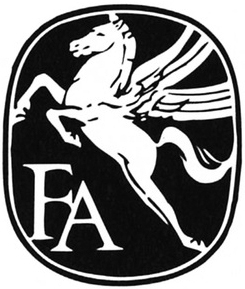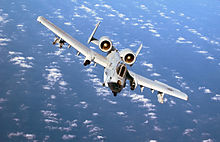Fairchild Aircraft
This article includes a list of general references, but it lacks sufficient corresponding inline citations. (April 2009) |
 | |
| Company type | Aircraft manufacturer |
|---|---|
| Founded | 1925 |
| Founder | Sherman Fairchild |
| Defunct | 2003 |
| Fate | Acquired by M7 Aerospace |
| Headquarters | , U.S. |
| Subsidiaries | Fairchild Aircraft Ltd. Ranger Aircraft Engine Division/Fairchild Engine Division |
Fairchild was an American aircraft and aerospace manufacturing company based at various times in Farmingdale, New York; Hagerstown, Maryland; and San Antonio, Texas.
History
Early aircraft


The company was founded by Sherman Fairchild in 1924 as Fairchild Aviation Corporation, based in Farmingdale, and East Farmingdale, New York. It was established as the parent company for Fairchild's many aviation interests. The company produced the first US aircraft to include a fully enclosed cockpit and hydraulic landing gear, the Fairchild FC-1. At some point, it was also known as the Fairchild Aircraft Manufacturing Company. The Fairchild Aircraft Ltd. of Longueuil, Quebec, Canada was an aircraft manufacturer during the period of 1920 to 1950, which served as a subsidiary of the Fairchild company of the United States. The Fairchild Engine Company was formed with the purchase of the Caminez Engine Company in 1925.[1] In 1929, Sherman Fairchild purchased a majority stock interest in Kreider-Reisner Aircraft Company of Hagerstown, Maryland. The company moved to Hagerstown in 1931.[2] A series of related designs beginning with the Fairchild FC-1 and continuing to the Fairchild 71 were designed for aerial photography as a result of dissatisfaction towards available aircraft which were incapable of flying steadily enough at a sufficient altitude.[3] In 1935, Fairchild was hired by the US government to do aerial photograph surveys of the United States to track soil erosion and its effects.[4] Their performance and carrying ability led to them becoming one of the most popular bushplanes of the era. A Fairchild 71 monoplane, the Virginia, was taken as one of three aircraft by Richard E. Byrd on his 1928–1929 expedition to the South Pole. It was used for test flights and reconnaissance.
World War II



During World War II, Fairchild produced PT-19/PT-23/PT-26 (Cornell) and AT-21 Gunner trainers, C-82 Packet transports and drones. The Fairchild AT-21 Gunner, a twin-engine trainer, was manufactured at a former rayon mill in Burlington, North Carolina. Also large numbers of the Fairchild 24 (C-61/Argus) were produced for the military (principally as the Argus for the Royal Air Force), and continued production after the war for the civilian market. Fairchild ranked 73rd among United States corporations in the value of World War II military production contracts.[5]
Postwar

The Fairchild C-119 Flying Boxcar was a US military transport aircraft developed from the World War II C-82 Packet. The C-119 could carry cargo, personnel, stretcher patients and mechanized equipment with the ability to make "paradrops" of cargo and troops. The first C-119 made its initial flight in November 1947, and by the time production ceased in 1955, more than 1,100 C-119s had been built for use in the USAF, the Royal Canadian Air Force and others. Many were converted into waterbombers after being retired from military service.
In 1949 the Hagerstown, Maryland Fairchild Engine and Airplane Corporation developed the Chase XCG-20 glider into the C-123 Provider transport which entered service in 1955. In 1954 Fairchild purchased the American Helicopter Company, incorporating it and the XH-26 Jet Jeep as a division.[6] In 1956, the company acquired rights to the Fokker Friendship, producing 206 of the aircraft as the Fairchild F-27 and Fairchild Hiller FH-227. During the 1950s, Fairchild was a large subcontractor to Boeing for B-52 fuselage sections and wing panels. Later they would build McDonnell-Douglas F-4 Phantom II tail sections, Grumman F-14 Tomcat tails, and Space Shuttle stabilizers.
Their association with Boeing would continue into the 1980s as they built wing control surfaces for 747s and 757s. In 1964, the company purchased Hiller Aircraft, changing its name to Fairchild Hiller and producing the FH-1100, until 1973 when the helicopter division was sold back to Stanley Hiller. In 1965, the company acquired the Republic Aviation Company.
Following the death of its founder, Fairchild changed its name to Fairchild Industries in 1971, before purchasing Swearingen and manufacturing the Fairchild Swearingen Metroliner, a successful commuter aircraft which gained orders from the US military as the C-26 Metroliner. In 1971 the company began developing the Fairchild Republic A-10 Thunderbolt II which prevailed over the rival Northrop YA-9 in the A-X competition for an eventual production run of 716 aircraft.
The company developed the T-46 jet trainer to replace the elderly Cessna T-37 Tweet trainer, but it was not accepted by the Air Force because of performance problems.
Aircraft production was ended in Hagerstown, Maryland in 1984.
After the company's takeover of Dornier's civil assets in 1996, the company was renamed Fairchild Dornier. The company commenced production of the Dornier 328 in 1998 under license from DASA.
In December 1999, Fairchild Aerospace Corporation was acquired by German insurer Allianz A.G. and the United States investment group Clayton, Dubilier & Rice Inc. for $1.2 billion.[7]
In 2003, the assets of Fairchild were purchased by M7 Aerospace and the new company was relocated to San Antonio.
On December 15, 2010, M7 was purchased by the United States subsidiary of the Israeli defense contractor Elbit Systems.[8]
Aircraft
Missiles
Spacecraft
See also
- Fairchild Industries
- Fairchild Corporation
- Fairchild Semiconductor
- Fairchild Camera and Instrument
- Ranger/Fairchild Engines
- List of aircraft engines
References
Citations
- ^ Donald M. Pattillo. A History in the Making: 80 Turbulent Years in the American General Aviation Industry. p. 11.
- ^ Kaske, Kristine L. "Fairchild Industries, Inc. Collection." National Air and Space Archives, 2003.
- ^ Donald 1997, p. 382.
- ^ "Wide Area Is Mapped From Air By Giant Ten Lens Camera." Popular Mechanics, October 1935. (Editors have stated Fairchild Aircraft in hand written comment to left of archived article.)
- ^ Peck, Merton J. & Scherer, Frederic M. The Weapons Acquisition Process: An Economic Analysis (1962) Harvard Business School p.619
- ^ "Flying Jeep." Popular Mechanics, September 1952, p. 44.
- ^ "Fairchild Aerospace is sold for $1.2 billion." The New York Times, 29 December 1999. Retrieved: 28 July 2011.
- ^ "Elbit Systems U.S. Subsidiary Completes Acquisition of M7 Aerospace for $85 Million". Elbit Systems. December 15, 2010. Retrieved 12 March 2016.
Bibliography
- Donald, David, ed. The Complete Encyclopedia of World Aircraft. New York: Barnes & Noble Books, 1997. ISBN 0-7607-0592-5.
External links
- Referenceforbusiness.com: History of Fairchild Aircraft, Inc. and associated companies
- Fairchild Industries Collection, National Air and Space Archives PDF — includes corporate history and chronology.
- Fairchild Controls Corporation company website
- M7 Aerospace company website
- Airfields-freeman.com: — WWII Fairchild trainer production at Greensboro N.C.
- Planesandchoppers.com: Photos of Fairchild aircraft
- Hagerstown Aviation Museum website — in Hagerstown (Maryland), headquarters of Fairchild Aircraft from 1931-1984, and "Home of the Flying Boxcar."
- Fairchild Corporation
- Aerospace companies of the United States
- Defunct aircraft manufacturers of the United States
- Manufacturing companies based in Maryland
- Manufacturing companies based in New York
- Manufacturing companies based in Texas
- American companies established in 1925
- Manufacturing companies established in 1925
- Manufacturing companies disestablished in 2003
- 1925 establishments in New York
- 1931 establishments in Maryland
- 2003 disestablishments in Texas
- Companies based in Nassau County, New York
- Companies based in San Antonio
- Washington County, Maryland
- Hagerstown, Maryland
- Defunct companies based in Maryland
- Defunct companies based in New York
- Defunct companies based in Texas
